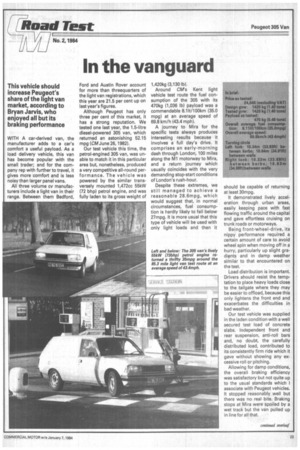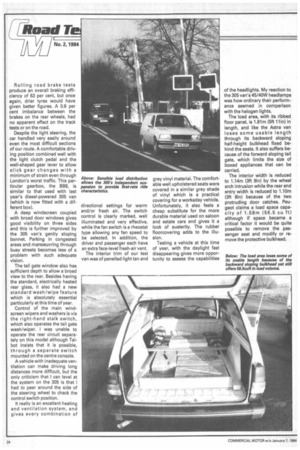This vehicle should increase Peugeot's share of the light van
Page 27

Page 28

Page 29

If you've noticed an error in this article please click here to report it so we can fix it.
market, according to Bryan Jarvis, who enjoyed all but its braking performance
WITH A car-derived van, the manufacturer adds to a car's comfort a useful payload. As a load delivery vehicle, this van has become popular with the small trader; and for the company rep with further to travel, it gives more comfort and is less noisy than larger panel vans.
All three volume cv manufacturers include a light van in their range. Between them Bedford. Ford and Austin Rover account for more than threequarters of the light van registrations, which this year are 21.5 per cent up on last year's figures.
Although Peugeot has only three per cent of this market, it has a strong reputation. We tested one last year, the 1.5-litre diesel-powered 305 van, which returned an astonishing 52.15 mpg (CM June 26, 19821.
Our test vehicle this time, the petrol-engined 305 van, was unable to match it in this particular area but, nonetheless, produced a very competitive all-round performance. The vehicle was powered by the similar transversely mounted 1,472cc 55kW (72 bhp) petrol engine, and was fully laden to its gross weight of 1,420kg (3,130 ib).
Around CM's Kent light vehicle test route the fuel consumption of the 305 with its 470kg (1,036 IW payload was a commendable 8.1It/100km (35.0 mpg) at an average speed of 69.8 km/h (43.4 mph).
A journey to Mira for the specific tests always produces interesting results because it involves a full day's drive. It comprises an early-morning dash through London, 100 miles along the M1 motorway to Mira, and a return journey which usually coincides with the very demanding stop-start conditions of London's rush-hour.
Despite these extremes, we still managed to achieve a reasonable 28.6mpg, which would suggest that, in normal circumstances, fuel consumption is hardly likely to fall below 27mpg. It is more usual that this type of vehicle will be used with only light loads and then it should be capable of returning at least 30mpg.
It demonstrated lively acceleration through urban areas, easily keeping pace with fast flowing traffic around the capital and gave effortless cruising on trunk roads or motorways.
Being front-wheel-drive, its nippy performance required a certain amount of care to avoid wheel spin when moving off in a hurry, particularly up slight gradients and in damp weather similar to that encountered on the test.
Load distribution is important. Drivers should resist the temptation to place heavy loads close to the tailgate where they may be easier to offload, because this only lightens the front end and exacerbates the difficulties in bad weather.
Our test vehicle was supplied in the laden condition with a well secured test load of concrete slabs. Independent front and rear suspension, anti-roll bars and, no doubt, the carefully distributed load, contributed to its consistently firm ride which it gave without showing any excessive roil or pitching.
Allowing for damp conditions, the overall braking efficiency was satisfactory but not quite up to the usual standards which I associate with Peugeot vehicles. It stopped reasonably well but there was no real bite. Braking stops at Mira were spoiled by a wet track but the van pulled up in line for all that. Rolling road brake tests produce an overall braking efficiency of 63 per cent, but once again, drier tyres would have given better figures. A 0.8 per cent imbalance between the brakes on the rear wheels, had no apparent effect on the track tests or on the road.
Despite the light steering, the car handled very easily around even the most difficult sections of our route. A comfortable driving position combined well with the light clutch pedal and the well-shaped gear lever to allow slick gear changes with a minimum of strain even through London's worst traffic. This particular gearbox, the BB8, is similar to that used with last year's diesel-powered 305 van (which is now fitted with a different box).
A deep windscreen coupled with broad door windows gives good visibility on three sides and this is further improved by the 305 van's gently sloping bonnet. Parking in congested areas and marroeuvring through busy streets becomes less of a problem with such adequate vision.
The tail gate window also has sufficient depth to allow a broad view to the rear. Besides having the standard, electrically heated rear glass, it also had a new standard wash/wipe feature which is absolutely essential particularly at this time of year.
Control of the main windscreen wipers and washers is via the right-hand stalk switch, which also operates the tail gate wash/wiper. I was unable to operate the rear circuit separately on this model although Talbot insists that it is possible, through a separate switch mounted on the centre console.
A vehicle with inadequate ventilation can make driving long distances more difficult, but the only criticism that I can level at the system on the 305 is that I had to peer around the side of the steering wheel to check the control switch position.
It really is an excellent heating and ventilation system, and gives every combination of
directional settings for warm and/or fresh air. The switch control is clearly marked, well illuminated and very effective, while the fan switch is a rheostat type allowing any fan speed to be selected. In addition, the driver and passenger each have an extra face-level fresh-air vent.
The interior trim of our test van was of panelled light tan arid
grey vinyl material. The comfortable well upholstered seats were covered in a similar grey shade of vinyl which is a practical covering for a workaday vehicle. Unfortunately, it also feels a cheap substitute for the more durable material used on saloon and estate cars and gives it a look of austerity, The rubber floorcovering adds to the illusion.
Testing a vehicle at this time of year, with the daylight fast disappearing gives more opportunity to assess the capabilities of the headlights. My reaction to the 305 van's 45/40W headlamps was how ordinary their performance seemed ;n comparison with the halogen lights.
The load area, with its ribbed floor panel, is 1.81m (Sit 11in) in length, and like the Astra van loses some usable length through its backward sloping half-height bulkhead fixed behind the seats. It also suffers because of the forward sloping tail gate, which limits the size of boxed appliances that can be carried.
The interior width is reduced to 1.14m (3ft 9in) by the wheel arch intrusion while the rear end entry width is reduced to 1.10m (3ft 8in) because of the two protruding door catches. Peugeot claims a load space capacity of 1.5 8m (56.5 Cu ft) although if space became a critical factor it would be quite possible to remove the passenger seat and modify or remove the protective bulkhead. Peugeot tilts the transverselymounted engine forward through 20 degrees to make the best possible use of the available space, and because the radiator is mounted in front of the engine, the cooling fan belt is driven from the crankshaft pulley through 90 degrees passing over two jockey wheels. Another belt drives the alternator.
The through-flow cylinder head has the intake manifold and ignition system mounted behind the engine with the exhaust manifold at the front to take full advantage of the cooling air flow. Exhaust gases flow through an expansion box and the silencer which is partition ed with an expensive looking external inter-connecting pipe.
Despite the compact layout, daily checks and service maintenance will present few problems in normal circumstances as oil filters and drain plugs are easily accessible. The 12mm spark plugs set deep in the cylinder head require a special plug spanner to remove them (one is provided, secured to the van's bulkhead). A tightening torque of 1.5-2m/kg (11.14ftlb) is recommended, but no torque wrench is provided for this.
Electrical fuses are equally accessible from the box mounted inside the engine compartment on the left side. These are all colour coded and clearly marked.
Summary
The Peugeot 305's main strengths lay in the van's firstrate ride together with its lively and economical performance. However, its braking performance failed to instil confidence and I found the interior noise levels higher than usual with this type of body.
This apart, many of the driving comforts have been retained from the saloon car from which it is derived, and, at £4,045 retail excluding vat, it provides healthy competition in the light van market.










































































